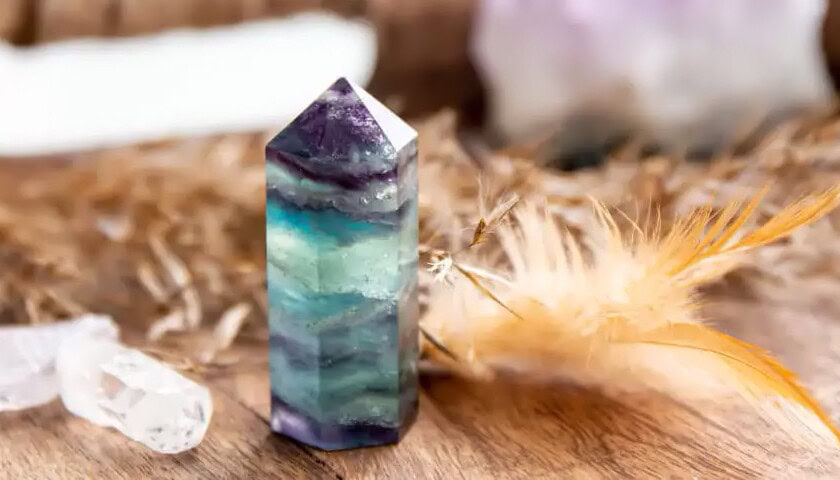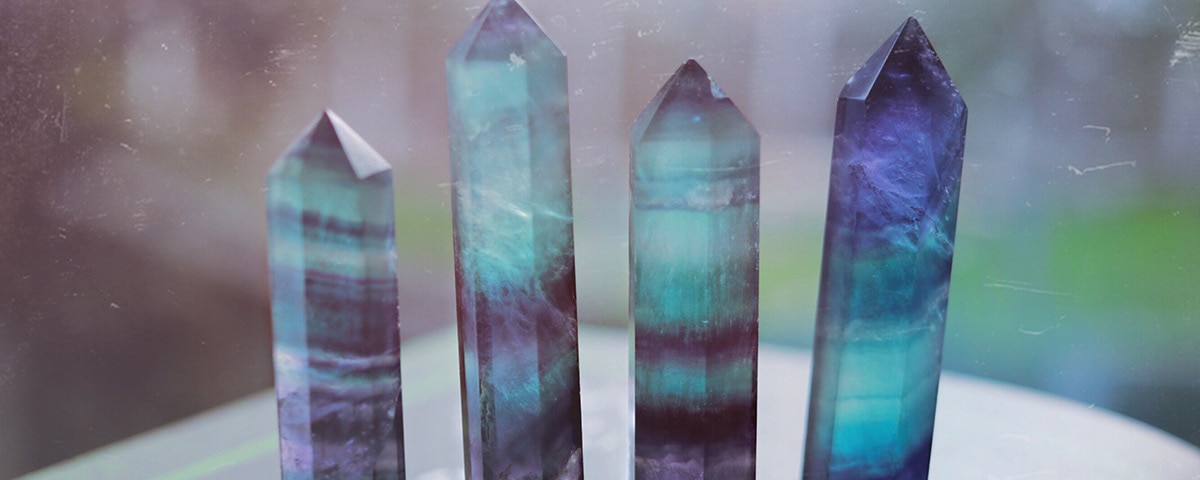Article Highlights
- Fluorite is a vibrant mineral that exhibits a wide spectrum of colors, earning it the title “the most colorful mineral in the world.”
- Fluorite’s beautiful colors are the result of impurities and exposure to radiation.
- This mineral is also recognized for its unique crystal habits, with cubic and octahedral structures being the most common.
- Fluorite exhibits the phenomenon of fluorescence, where it glows when exposed to ultraviolet light.
- Major deposits of fluorite are found around the globe, notably in China, South Africa, and Mexico.
When you first lay eyes on a piece of Banded Fluorite, there’s no denying its draw. It’s like stepping into a rainbow, with each band revealing a new color and a new layer of intrigue. From purples and blues to greens, yellows, and even striking blacks, it’s a natural kaleidoscope right there in your hands.
But what’s behind this breathtaking display? The magic lies in the impurities and exposure to radiation. Different impurities and varying degrees of radiation exposure work together to paint this vibrant array of colors. It’s Mother Nature’s canvas, a testament to the artistry at the heart of our natural world.
The Shape of Beauty: Crystal Habits of Fluorite
Fluorite isn’t just about colors; it’s about shapes too. This mineral has a knack for forming in well-structured crystals, particularly cubes and octahedrons. A cubic fluorite crystal is a sight to behold — each side equal, each angle precise. The octahedron, with its eight striking faces, offers another geometric spectacle.
And there’s more than just aesthetics to these shapes. The forms can offer insights into the conditions under which the fluorite formed. For instance, it’s believed that octahedral fluorite forms at higher temperatures than its cubic counterpart. So next time you see a piece of fluorite, remember, you’re not just seeing a gem — you’re witnessing a geological story unfold.
Dancing in the Light: Fluorescence and Fluorite
Have you ever seen a stone glow? Fluorite can do that. When exposed to ultraviolet light, many types of fluorite emit a vibrant light — a mesmerizing dance of colors that never fails to captivate. This phenomenon, known as fluorescence, led to fluorite being the namesake for such a display.
Under the UV light, fluorite can beam with colors ranging from blue, red, purple, to yellow, green, or even white. These individual light shows depend on the specific impurities within the fluorite’s crystal lattice. It’s another reminder of how even the smallest variations can create an entirely new visual experience.
A Global Rainbow: Fluorite Deposits Around the World
Fluorite’s charm knows no borders. From the southernmost tip of Africa to the vast landscapes of China, and all the way to the diverse terrains of Mexico, you’ll find fluorite making itself known. And each deposit has its unique charm, contributing a new chapter to fluorite’s worldwide story.
China stands as a titan in the world of fluorite, producing significant quantities of this mineral every year. It’s here that the heart of the fluorite world beats, creating a rhythm that reverberates across the globe.
But let’s not forget about South Africa and Mexico. These countries host substantial fluorite deposits, playing their part in the global supply of this captivating mineral. Each region adds its unique touch, painting the world with the colors of fluorite.
History and Lore of Banded Fluorite
Picture the scene: the 16th century is in full swing, and our hero, a metallurgist by the name of Georgius Agricola, is wrestling with the challenges of smelting ores into pure metals. Suddenly, a mineral that was previously just a vibrant backdrop in the geological landscape comes to the rescue: fluorite, or as Agricola called it, ‘fluorspar’. This stunning mineral revolutionized metallurgy, facilitating the smelting process with its unique properties.
But Agricola’s discovery was merely the opening chapter in the riveting saga of fluorite’s journey across time and cultures.
The Scientific Milestones
Fast forward to the 19th century, and we find British physicist Sir George Gabriel Stokes making a remarkable observation. He discovered that fluorite glows a beautiful blue color under ultraviolet light. This radiant display was so distinctive and unforgettable that he coined a new term to describe it: ‘fluorescence’. In doing so, he forever linked this phenomenon to the mineral that inspired its discovery.
Then, in 1886, fluorite once again etched its name in scientific history. French chemist Ferdinand Frederic Henri Moissan managed to isolate the element fluorine from fluorite, marking a significant milestone in the world of chemistry. The newly discovered element was fittingly named after the mineral that made it all possible, further cementing fluorite’s scientific legacy.
The Symbolic and Therapeutic Significance
Fluorite’s history isn’t confined to the annals of science. Its cultural footprint is equally remarkable, as it held symbolic and therapeutic value in various societies.
Ancient Romans, for instance, were convinced that drinking from fluorite vessels could ward off intoxication. This was a belief mirrored in several other cultures, demonstrating fluorite’s universal appeal as a protective amulet. Romans also valued fluorite for its rarity and intricate banding, considering it a symbol of wealth and luxury.

In ancient Chinese culture, fluorite was revered as a protection from evil spirits, and its clusters were considered “dream makers”, believed to bring about enlightenment and wisdom. Ancient Egyptians were also admirers of fluorite, using it to carve scarabs and statues of the gods.
Flourite Artifacts: Treasures from the Past
Fluorite’s beauty was universally recognized and celebrated in the form of stunning artifacts. Romans, Celts, Britons, French, Germans, and American Indians, among others, carved fluorite into various forms such as figurines, deity statues, totems, amulets, talismans, bowls, cups, dishes, and vases.
Numerous such artifacts have been unearthed, particularly in the southern Illinois-western Kentucky Fluorspar region of America. These exquisite carvings, dating from the Mississippian Moundbuilders era (900-1650 A.D.), reflect fluorite’s deep cultural significance in the native societies of the Mississippi Valley.
Roman nobility also had a penchant for fluorite. Emperor Nero is said to have paid a princely sum for a fluorspar cup, and Julius Caesar’s predecessor, “Pompey the Great,” is reported to have claimed six fluorite vases from Mithridates’ treasure for himself.
Fluorite in Health and Wellness
Fluorite’s journey is not limited to the realms of science and culture. It also traversed the path of health and wellness. In the 18th century, it was used as a remedy for kidney disease when ground into powder and mixed with water. Later, hydrofluoric acid derived from fluorite was used for etching glass, and when diluted, was said to alleviate kidney disease symptoms, shrink varicose veins, and even promote hair growth.

In an early 18th-century German experiment, a woman reported to have clairvoyant powers experienced deep muscle relaxation and entered a trance-like state upon contact with fluorite, indicating its potential therapeutic qualities.
Fluorite Museums: Celebrating the Mineral
Today, there are museums worldwide dedicated to showcasing fluorite’s rich history and many of them sit on the sites of former mines. One such museum, the Ben E. Clement Mineral Museum in Marion, Kentucky, houses the world’s largest fluorite collection. These institutions stand as testaments to the enduring fascination and love for this remarkable mineral.
Banded Fluorite: A Rainbow of Meanings and Symbolism
Unlock the mystical world of Banded Fluorite, a mineral admired for its entrancing bands of color, often compared to a crystallized rainbow. This beautiful stone holds a wealth of symbolism and deeper meanings that span across cultures and ages.
Revered as the “home of the rainbow,” Banded Fluorite’s multiple hues represent an array of positive energies. Each color holds a unique vibration, creating a symphony of healing, protection, and enlightenment. For centuries, it has been considered a guardian against evil spirits and a conduit to spiritual awakening.
The stone’s banding symbolizes unity and harmony, reminding us of our ability to adapt, grow, and flow with life’s changes, just as each band seamlessly transitions into the next.
Unveiling the Magic of Purple Banded Fluorite
Enter the captivating realm of Purple Banded Fluorite, a spellbinding mineral renowned for its deep violet hues. This extraordinary stone holds a rich, vibrant color palette, a testament to the mysteries and depth of the universe.
Purple Banded Fluorite is not only a sight to behold but also a powerhouse of calming and intuitive energies. The color purple is universally recognized as a spiritual and mystic hue, making this variant of fluorite a favored companion for meditation and spiritual work.
Purple Banded Fluorite helps to open the third eye, awakening intuition and fostering a deeper understanding of oneself and the world around us. Its calming energy aids in mental clarity, supporting the ability to make complex decisions and encourage emotional balance.
Frequently Asked Questions About Banded Fluorite
What is Banded Fluorite?
Banded Fluorite is a form of the mineral fluorite that features distinct bands or stripes of different colors. It’s often used for ornamental and lapidary works due to its aesthetic appeal.
What colors does Banded Fluorite come in?
Banded Fluorite can occur in a variety of colors, including green, purple, blue, yellow, and clear. The bands often appear in multiple colors in a single specimen.
Where can Banded Fluorite be found?
Banded Fluorite can be found in many locations worldwide, including Mexico, South Africa, China, Canada, the U.S., and parts of Europe.
Can I put my Banded Fluorite in water?
No, it’s not recommended to submerge Banded Fluorite in water, as it might damage the crystal over time.
Can Banded Fluorite be exposed to sunlight?
Prolonged exposure to direct sunlight may cause some types of Banded Fluorite to fade. It’s best to keep it away from direct sunlight.
| Banded Fluorite Physical Properties | |
|---|---|
| Crystal Structure | Isometric (cubic) |
| Mineral Class | Halides |
| Specific Gravity | Approx. 3.1 – 3.3 |
| Formula | CaF2 |
| Hardness | 4 on Mohs scale |
| Transparency | Transparent to translucent |
| Chemical Composition | Calcium fluoride |
| Locations | Globally, with significant deposits in China, Mexico, South Africa |
| Rarity | Common |
| Can Be Submerged in Water | Yes, but not for prolonged periods |
| Sun Safe Crystal | No, prolonged exposure to sunlight can fade color |
| Special Care Instructions | Avoid harsh chemicals. Handle with care due to its softness. Keep out of direct sunlight |
| Price/Carat | Typically ranges from $1 to $5 per carat, higher for exceptional pieces |
| Banded Fluorite Metaphysical PropertiesDetails | |
|---|---|
| Chakras | Heart Chakra, Throat Chakra, Third Eye Chakra |
| Zodiac Signs | Capricorn, Pisces |
| Planets | Neptune |
| Numerical Vibration | Number 7 |
| Elements | Air, Water |
| Symbolism | Intuition, Connection, Harmony |
| Birthstones | Not traditionally a birthstone |
| Affirmations | “I am balanced and in tune with all my emotions”, “I am filled with clarity and understanding” |
| Emotional Conditions | Helps with emotional balance, mental clarity, decision-making |
| Spiritual Purposes | Enhances intuitive abilities, connection to spiritual realms |
| Crystal Combinations | Amplified by Clear Quartz, grounded by Hematite, balances with Amethyst |



